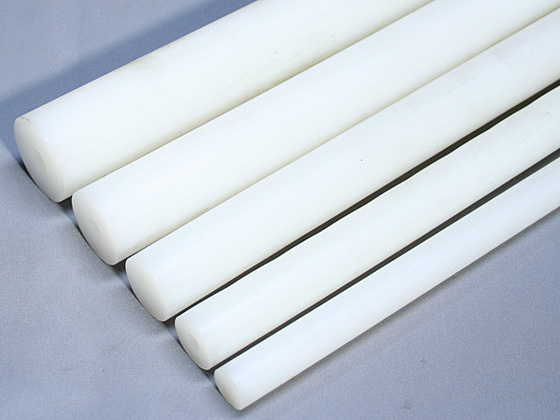 |
 |
These are the properties of UHMWPE (Ultra-High-Molecular-Weight Polyethylene), a material used in plastic bearings. Take a look at the characteristics of this material.
Overview of UHMWPE
UHMWPE (Ultra-High-Molecular-Weight Polyethylene) is a type of polyethylene with extremely high molecular weight bonding, which belongs to the olefin-based plastics. It is mainly composed of ethylene and is produced through advanced polymerization techniques. UHMWPE is an extremely high molecular weight, special thermoplastic resin.
Due to its different processing methods and properties, it differs significantly from ordinary polyethylene. It possesses remarkable stretchability and is the material with the most demanding surface finishing. It exhibits excellent abrasion resistance, retains its properties even at low temperatures, and is resistant to chemicals. Additionally, it is low in water absorption, lightweight, and rarely produces toxic gases even when burned.
These characteristics define UHMWPE (Ultra-High-Molecular-Weight Polyethylene), the material used in plastic bearings. Please check the unique features of this material.
Main applications of UHMWPE
Hoppers for materials such as cement and coal, ice rinks, doctor blades, bearings, gears and gearboxes, electrocoating components, artificial joints, ship components, etc.
Characteristics of UHMWPE
◎Recommended ○Satisfactory △Possible to use, but not recommended ×Not compatible
| Material | Product Code |
Dry | Water (extended periods of time) |
Water |
Steam | Chemical Environment | Magnetic Environment |
As Insulator |
|||
|---|---|---|---|---|---|---|---|---|---|---|---|
| Acids | Alkaline | Organic Liquids |
Oil | ||||||||
| Phenol | SD | ◎ | ◎ | ◎ | ◎ | ○ | × | ◎ | ◎ | ◎ | ◎ |
| SDK | ◎ | ◎ | ◎ | ◎ | ○ | × | ◎ | ◎ | × | × | |
| SDHG | ◎ | △ | △ | × | ○ | × | ○ | ◎ | × | × | |
| PTFE | PT | ◎ | ◎ | ◎ | ◎ | ◎ | ◎ | ◎ | ◎ | ◎ | × |
| PTG | ◎ | ◎ | ◎ | ◎ | ◎ | × | ◎ | ◎ | ◎ | ◎ | |
| PTE | ◎ | ◎ | ◎ | ◎ | ◎ | ◎ | ◎ | ◎ | ◎ | ◎ | |
| PTN | ◎ | ◎ | ◎ | ◎ | ◎ | ◎ | ◎ | ◎ | ◎ | ◎ | |
| UHMWPE | PE | ○ | ○ | ◎ | × | ◎ | ◎ | ◎ | ◎ | ◎ | ◎ |
| PP | PP | △ | ○ | ○ | △ | ○ | ○ | ○ | ○ | ◎ | ◎ |
| PEEK | PK | ○ | ○ | ○ | ○ | ◎ | ◎ | ◎ | ◎ | ◎ | ◎ |
| PKG | ◎ | ○ | ○ | ◎ | ◎ | ◎ | ◎ | ◎ | ◎ | × | |
| PPS | PS | ○ | ◎ | ◎ | ◎ | ◎ | ◎ | ◎ | ◎ | ◎ | ◎ |
| PSG | ◎ | ◎ | ◎ | ◎ | ◎ | ◎ | ◎ | ◎ | ◎ | × | |
| PCTFE | PCT | ○ | ○ | ○ | ◎ | ◎ | ◎ | ○ | ○ | ◎ | ◎ |
| PVDF | PV | ○ | ○ | ○ | ◎ | ◎ | ◎ | ○ | ○ | ◎ | ◎ |
| Carbon | CY | ◎ | ○ | ○ | ◎ | ◎ | ◎ | ◎ | ◎ | ○ | × |
Note: Please contact us for detailed information regarding compatibility with specific chemicals.
Temperature resistance performance of UHMWPE
☆Highly recommended ◎Recommended ○Satisfactory △Possible to use, but not recommended ×Not compatible
| Material | Product Code |
Temperature | |||||||
| -190℃~ | -100℃~ | -50℃~ | -20℃~ | Room or Operating Temperature | ~120℃ | ~200℃ | ~350℃ | ||
| Phenol | SD | × | × | 〇 | ◎ | ☆ | ◎ | × | × |
| SDK | × | × | 〇 | ◎ | ☆ | ◎ | × | × | |
| PTFE | PT | 〇 | ◎ | ◎ | ◎ | ☆ | ◎ | △ | × |
| PTG | 〇 | ◎ | ◎ | ◎ | ☆ | ◎ | △ | × | |
| PTE | 〇 | ◎ | ◎ | ◎ | ☆ | ◎ | △ | × | |
| UHMWPE | PE | × | △ | 〇 | 〇 | ☆ | × | × | × |
| PP | PP | × | △ | 〇 | 〇 | ☆ | 〇 | × | × |
| PEEK | PK | × | × | 〇 | ◎ | ☆ | ◎ | 〇 | × |
| PKG | × | × | 〇 | ◎ | ☆ | ◎ | ◎ | × | |
| PPS | PS | × | × | × | 〇 | ☆ | ◎ | 〇 | × |
| PSG | × | × | × | 〇 | ☆ | ◎ | 〇 | × | |
| PCTFE | PCT | × | × | 〇 | ◎ | ☆ | 〇 | × | × |
| Carbon | CY | × | × | △ | 〇 | ☆ | ◎ | ◎ | ◎* |
*Note: Please consider the coefficient of thermal expansion, or contact us for specialized applications.

